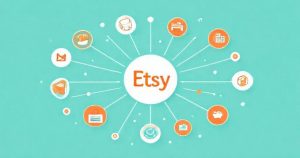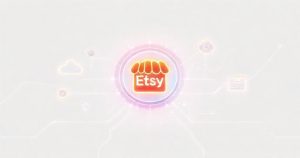Etsy has become a vibrant marketplace for creators and entrepreneurs, offering a unique platform to sell handmade goods and vintage items. As shops grow, managing orders, inventory, shipping, and customer communications can become increasingly complex. This is where Etsy integrations play a pivotal role, transforming manual, time-consuming tasks into streamlined, automated processes. Understanding how these integrations work and which ones are most beneficial is crucial for any seller looking to scale their business and maintain a competitive edge in the digital crafting world.
Understanding the Power of Etsy Integrations
Etsy integrations refer to third-party software applications or services that connect directly with your Etsy shop, allowing data to flow seamlessly between platforms. These tools are designed to extend the functionality of your Etsy store, addressing specific operational needs that the core Etsy platform might not cover in depth. From automating crucial business processes to providing insightful analytics, these integrations empower sellers to manage their operations more effectively, saving valuable time and reducing the potential for human error. They are essential for scaling a small business.
1. Essential Types of Etsy Integrations for Sellers
The landscape of Etsy integrations is diverse, catering to various aspects of e-commerce management. Shipping integrations, for example, connect your shop directly to carriers, automating label creation and tracking updates. Accounting integrations link sales data to financial software, simplifying bookkeeping and tax preparation. Inventory management tools ensure stock levels are accurate across all sales channels, preventing overselling. Marketing integrations can help automate email campaigns or social media posts, reaching customers more efficiently and broadening your brand’s reach. Print-on-demand services integrate seamlessly, automating product creation and fulfillment.
2. Streamlining Order and Inventory Management
Efficient order and inventory management are critical for any Etsy shop’s success. Integrations in this category, such as those offered by platforms like eSwap or Sellbrite, synchronize stock levels across multiple platforms if you sell beyond Etsy. This prevents the common issue of selling an item that is out of stock, leading to improved customer satisfaction. These tools often provide a centralized dashboard to view all orders, update statuses, and manage product listings. The automation of these tasks allows sellers to focus more on creation and less on administrative burdens, proving the value of Etsy integrations in operational efficiency.
3. Optimizing Shipping and Fulfillment Processes
Shipping integrations are among the most impactful tools for Etsy sellers. Services like ShipStation or Pirate Ship directly pull order information from your Etsy shop, allowing you to compare shipping rates, print labels in bulk, and automatically send tracking information to customers. This not only saves significant time but can also lead to cost savings through discounted shipping rates often available via these platforms. For instance, a small business shipping 50 orders a week might save $1-$2 per label, accumulating to hundreds of dollars monthly. This optimization highlights a key benefit of effective Etsy integrations.
4. Simplifying Accounting and Financial Tracking
Managing finances is often a daunting task for small business owners. Etsy integrations with accounting software like QuickBooks Online or Xero automate the transfer of sales data, expenses, and transaction fees directly into your ledger. This ensures accurate financial records, simplifies tax season, and provides a clear overview of your shop’s profitability. Instead of manually entering dozens of transactions, the integration performs this task instantly and flawlessly. Sellers can gain valuable insights into their revenue streams and identify areas for financial improvement, making these integrations invaluable for strategic planning.
5. Enhancing Customer Relationships and Marketing Efforts
Building strong customer relationships is vital for repeat business on Etsy. Integrations with email marketing platforms like Mailchimp or ConvertKit can automatically add new customers to your mailing list, allowing you to send newsletters, promotional offers, and updates. This personalized communication fosters loyalty and encourages future purchases. Furthermore, some tools facilitate social media scheduling, helping you maintain a consistent online presence without constant manual updates. These marketing-focused Etsy integrations are powerful for expanding your brand’s reach and nurturing a dedicated customer base.
6. Exploring Print-on-Demand and Dropshipping Integrations
For sellers offering custom designs or expanding their product lines without managing physical inventory, print-on-demand (POD) and dropshipping integrations are game-changers. Platforms such as Printful or Printify seamlessly connect with Etsy, allowing you to create product mockups and automatically fulfill orders as they come in. When a customer purchases a POD item, the order is sent directly to the supplier for printing and shipping. This model significantly reduces overhead costs and inventory risks, making it an attractive option for many Etsy entrepreneurs, demonstrating the versatility of Etsy integrations.
7. Calculating Potential ROI and Cost Considerations
While many Etsy integrations offer free basic plans, advanced features typically come with a monthly subscription, ranging from $10 to $100 or more, depending on the service and volume. It is crucial for sellers to evaluate the return on investment (ROI). Consider the time saved, the reduction in errors, and the potential increase in sales or efficiency. For example, an integration costing $30/month that saves you 5 hours of manual work (valued at $20/hour) yields a clear positive ROI of $70. Carefully analyzing your operational needs against the cost of an integration ensures a wise investment.
8. Challenges and Best Practices for Implementation
Implementing Etsy integrations can present challenges, such as initial setup complexity, data synchronization issues, or learning curve for new software. To mitigate these, always start with a clear understanding of your specific needs and research user reviews thoroughly. Begin with one or two essential integrations, master them, and then gradually expand. Regularly monitor data flow to ensure accuracy and utilize customer support if issues arise. Prioritizing robust security features and reliable customer support from integration providers are also crucial best practices for smooth operation and data integrity.
Choosing the Right Integrations for Your Etsy Shop
Selecting the most suitable Etsy integrations requires a thoughtful assessment of your current business needs, future growth plans, and budget. Consider which tasks consume the most time or are prone to errors in your current workflow. Are you struggling with inventory accuracy, slow shipping, or overwhelming bookkeeping? Prioritize integrations that directly address these pain points. Look for platforms that offer scalability, excellent customer support, and clear pricing structures. A strategic approach to choosing integrations will empower your Etsy shop to operate at peak efficiency, fostering sustainable growth and reducing operational stress.





